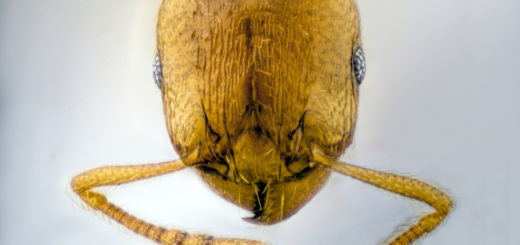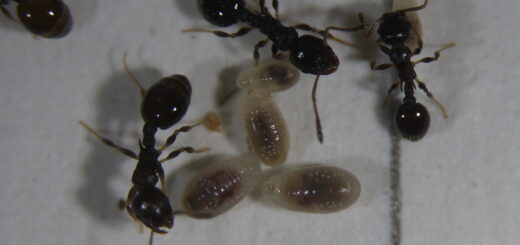Amber insights: a putative ancestor “too early” and the legacy of Gennady M. Dlussky
In the recently published paper “A new extinct ant genus (Hymenoptera: Formicidae: Myrmicinae) from the Late Eocene Rovno amber – a putative ancestor of the Leptothorax genus group” in Myrmecological News, Alexander G. Radchenko, Gennady M. Dlussky†, and Ksenia Perfilieva describe a new genus and a new species of ant, Proleptothorax primitivus, which they suggest as a putative ancestor of the extant genera of the Leptothorax genus group. In this Review, Phillip Barden highlights both their main points and the legacy of Gennady M. Dlussky.
A Review compiled by Phillip Barden 
While others may find alternative avenues of interest in this paper by Radchenko & al. (2018), to my eye, it is remarkable for three reasons. First, Eocene-aged European amber, despite over 200 years of study spanning tens of thousands of specimens and more than 150 described fossil ant species, is still providing important insights into ant evolution. Second, if this new species’ suspected systematic position is accurate, it predates molecular estimates for its closest living monophyletic group by nearly 20 million years. And third – and perhaps most important in the context of this post – it marks the 12th posthumous publication for the most prolific and knowledgeable paleomyrmecologist who ever lived. In this paper, Radchenko, Dlussky†, and Perfilieva describe Proleptothorax primitivus, a new fossil genus and species that appears to be an early member of the recently defined Leptothorax genus group. The description is based on two specimens from Ukrainian Rovno amber.
European amber insights 200 years later
Modern paleomyrmecology began in earnest with Eocene-aged European amber. The ants of so-called Baltic amber were investigated thoroughly by Gustav L. Mayr in 1868 in his massive monograph, which delimited an incredible 1400 amber specimens into 49 species. This was followed by William Morton Wheeler, who incorporated Mayr’s collection into one built by Ernest André and himself. Wheeler’s (1915) monographic study of over 10,000 Baltic amber ant specimens remains a classic. In the hundred years since, thousands and thousands of specimens have continued to yield new discoveries. A recent study by Penney & Preziosi (2014) suggests that an incredible ~30% of Baltic amber ant species are yet to be discovered. Even though the ants of Ukrainian Rovno amber, the focus of this paper, have only been formally worked on beginning in 2002, there are now 21 species described. The age and botanical origin of this amber are contentious, with some arguing the deposit is identical to redeposited Baltic amber, and others insisting the amber is a unique deposition in its own right. In any case, Rovno amber has been known by humans since Paleolithic times, evidenced by ancient jewelry, and is estimated to be between ~33 and 38 million years old. One might think that European amber fauna would have few surprises left in store after centuries of study, but it is clear that we still have a lot of work to do.

Electromyrmex wheeleri male holotype (© Alexander G. Radchenko)
On ancestors and a fossil “too soon”
In the case put forward by Radchenko & al., a surprise comes in the form of two male ants that look to be morphological mosaics of a particular modern group and extinct, potentially ancestral, lineages. Proleptothorax primitivus possesses some of the same diagnostic features of modern Leptothorax genus group species, including palp modifications and mesosomal sculpture, along with non-Leptothorax-like antennal morphology and wing venation that is presumed to be ancestral. The authors therefore propose that Proleptothorax represents an ancestral form of the Leptothorax genus group [comprising the Holarctic genera Formicoxenus + Harpagoxenus + and Leptothorax], which was established by Ward & al. (2015) and Prebus (2017). The challenge in any fossil systematic work is to place the taxon of interest in a systematic framework that is built around living fauna. It is difficult enough to identify clean synapomorphies for extant groups. When a temporal dimension is introduced, synapomorphic boundaries become unreliable and restrictive, as are keys or diagnoses based on modern taxa. The description and contextualization undertaken by Radchenko and colleagues required detailed comparison with living species, including SEM imaging. A fossil that possesses some but not all of the defining features of a modern group may in fact belong to the same lineage but could have diverged prior to the most common recent ancestor of all living group members. Subsequent extinction in the early-diverging lineage results in what is called a stem-lineage. Consider the dinosaurs. Non-avian theropod dinosaurs diverged prior to the most recent common ancestor of living bird species, but went extinct while possessing some but not all of the features that define extant birds. Some people therefore call dinosaurs the ancestors of birds.

Proleptothorax male holotype, dorsal view. (© Alexander G. Radchenko)
I think the word “ancestor” can be both helpful and confusing, particularly for folks who aren’t caught up in the world of systematics. The word as defined indicates that an ancestor is what ultimately gives rise to subsequent lineages. The word is helpful in that it immediately conveys the idea that the taxon in question possesses some ancestral features and can provide insight into early phenotype or timing. The word can be confusing because it may mask the reality, for those who are not well-versed in thinking this way, that the fossil may not be a true “ancestor” in the sense that it directly gave direct rise to subsequent living lineages. It is difficult not to think of fossils as intermediates, however, any fossil, even one with some presumably ancestral traits, may represent a significant divergence from the most common recent ancestor of living species – the true hypothetical ancestor. While it may seem like a stepping stone on the way to modern Leptothorax group species, it is important to consider that this may be the tip of the iceberg and that Proleptothorax may be a member of a lineage that could even have once extended well beyond modern Leptothorax in terms of diversity and ecological impact. Additionally, Proleptothorax could reflect a phenotypically divergent path from the common ancestor of itself and the Leptothorax genus group and therefore might be misleading in providing clues into ancestral morphology. The authors here acknowledge this reality by referring to the fossil as a “putative ancestor” and highlighting that there are no features which set Proleptothorax apart from modern Leptothorax genus group species, other than it’s plesiomorphies, or, ancestral characters. Absent of any features [so-called apomorphies] which would identify Proleptothorax as a distinct lineage, it seems likely that this taxon exhibits some aspects of early Leptothorax genus group male morphology. Proleptothorax seems to hang off of the exceedingly long branch between Leptothorax genus group and its sister taxon Temnothorax. Importantly, this new species also sets an intriguing temporal post in the ground to consider. Molecular estimates suggest the Leptothorax genus group originated in the Miocene approximately 10 million years ago. If the proposed systematic position of Proleptothorax is accurate, it would be considerably older than the origin of its closest living relatives, indicating that aspects of the Leptothorax genus group phenotype were in place well into the Eocene.

Gennady M. Dlussky in 2001 (© Michail Dlussky)
The legacy of Dlussky
There is an adage in biology when it comes to linking concepts in the literature to their founders: if it isn’t Darwin, it’s probably Wilson. When it comes to fossil ant species, I find that it’s much simpler: if it isn’t Dlussky, check again, it’s probably Dlussky. In the over fifty years since he began working in paleomyrmecology, Gennady Dlussky described over one third of the over 730 known fossil ant species – more than twice Wheeler and Mayr’s combined herculean efforts. Beyond the descriptions themselves, Dlussky made important contributions to biogeography, systematics, and predictions of early ant behavior. This most recent publication marks Dlussky’s 12th since his death, and I am sure his ideas will continue to be introduced into the literature for many years to come. I never met Dlussky and so to provide some insight into his remarkable life, process, and work, I asked his colleagues and frequent coauthors, Alexander Rasnitsyn, Ksenia Perfilieva, and Alexander Radchenko for their thoughts. I originally intended to edit their responses into a kind of narrative, but I think their words speak best for themselves:

The first entomological studies in Dlussky’s childhood (KUBZ), 1953. (© KUBZ)
[My questions in bold – responses with minor edits]
How did Dlussky first become interested in ants?
“He was a schoolboy and he came to Moscow Zoo. There was (and it exists till now!) a club of young biologists of the zoo. There he started his myrmecological career! As I remember, Prof. Rasnitsyn (also schoolboy at that time!) was his fist “supervisor” in this club, and he can tell you much more on this subject.”
I’ve learned that Dlussky became interested in ants at the same Moscow Zoo club that you attended. Do you know what drew Dlussky to become interested in ants specifically at that club?
“The child club at the Moscow Zoo (literal translation from the Russian: The Circle of Young Biologists at the [Moscow] Zoo, abbreviated KUBZ) was and is a very special entity that exists uninterrupted since 1924 and differs from other similar organizations. First, students operate with a high level of autonomy and self-administration, and second, a very high level of motivation to make real contributions to science, even though many persons attend it as young as 10-12 years old. And many continue that connection into their old age (like me, now 82).
Gennady (Gena) Dlussky entered the KUBZ in 1952 (after me). My memory has not kept events of such a remote past, but Gena himself reminded me of them a couple of years before his death. Initially, like most KUBZ people of his age, he dreamed to study something ‘big and dangerous’, particularly big cats, and this was really possible there. But many of us spent summer time out of town, and instead of bird watching and studying their life, another popular activity in our group, Gena turned his attention to carrion beetles (Nicrophorus) well known for their complicated behavior. He soon realized that corpses of small beasts and birds used as a bait attracted ants well before carrion beetles and wrecked his observations. He came to me for advice, and I suggested that he observe ants which are more interesting than carrion beetles. This turned out to be the beginning of the story. We became close friends until his death. We even became relatives: My brother married his sister (both KUBZ alumni as well).”
– Alexander Rasnitsyn
Dlussky’s first papers were taxonomic in nature and centered around extant species, what drew Dlussky to fossils?
“Well, that’s easy, considering the answer to the first question. After graduating from the university, Dlussky did great work on the taxonomy and morphology of the recent ants in the Laboratory of Soil Insects in the A.N. Severtsov Institute of Ecology and Evolution of the Soviet Academy of Sciences (SAS). He participated in several expeditions. His friend and colleague from the childhood of the KUBZ, paleoentomologist Alex Rasnitsyn, provided material from Baltic amber, stored in the collection of the Paleontological Institute of SAS, for Dlussky’s doctoral study of ants of the genus Formica (Dlussky 1967). Good paleontological collections were collected at the Paleontological Institute during numerous Soviet expeditions and needed an examination by a myrmecologist. So Dlussky began to work with fossil material (Dlussky 1975).”

“Interestingly, Dlussky never considered himself a strict ant taxonomist (as he said to me many times); perhaps just taxonomy was less interesting for him, there were many other greater interests! When I was slowly becoming a more experienced taxonomist, Dlussky simply “left” taxonomy of modern ants for me, and paid more and more attention to fossil ants. I joined these studies (with Dlussky) later. Myrmicine ants were not Dlussky’s favorite, instead he loved Formicinae and Dolichoderinae, and he proposed me to elaborate fossil Myrmicinae together. The results you may see in our publications…”
– Alexander Radchenko

Dlussky was a gifted person: he composed and sang songs. Photo taken in Valdai, his favorite summer dacha, 2001. (© Ksenia Perfilieva)
According to the records I keep, Dlussky is responsible for approximately one third of all described fossil ant species. This dwarfs other myrmecological greats such as Heer, Wheeler, and Mayr – what would you say allowed him to make such an incredible contribution to myrmecology?
“To my understanding, these were the same things that distinguish any big scientist in a field based primarily on observation: high motivation to gain new knowledge, high curiosity, high creativity, high responsibility for presenting reliable results (exactingness to oneself, restless attempt to falsify one’s own scientific inferences), high working capacity. Also, serious scientific education: KUBZ for the beginning, followed with Chair of entomology, Moscow State University and personal guidance by Dr. Constantine Arnoldi, a Russian expert in ants. And being a good friend of many, which makes colleagues happy to help. Gena was great in all these features.”
– Alexander Rasnitsyn
“There seem to be several reasons for this: incredible diligence, amazing talent and wide erudition. The talent of Gennady Dlussky was that he could see the picture in whole. In Russian: “to see the forest behind trees”. This ability helped him to highlight the main things and spend less time and energy on insignificant ones. By the way, among his friends-colleagues he was jokingly called the Genius Mikhailovich, in Russian transcription his name is the same as this word.
He himself conducted experimental work, participated in expeditions, was not afraid to learn new methods, but also did not follow the scientific mainstreams. In the Russian scientific community, there is a very popular saying of Soviet physicist, academician of the SAS, Lev Andreevich Artsimovich: “Science is the best way to satisfy personal curiosity at the state expense”. Many Soviet and Russian scientists are engaged in science for the sake of curiosity, it’s not like a business or a career. Dlussky is one of them. He worked with pleasure for himself.”
– Ksenia Perfilieva
Is there anything about who Dlussky was that you think should be included?
“Dlussky was a gifted person: he wrote verses, composed songs (music and verses), drew cartoons and funny pictures, composed funny sketches and organized their presentation, sang and played guitar. He was a centre of a company. He was a kind person with a fine taste of humor and was liked by almost everybody. And he was a good teacher (a successful university professor). We miss him badly.”
– Alexander Rasnitsyn

G. M. Dlussky, about 1993. (© Ksenia Perfilieva)
References
Dlussky, G.M. 1967: Ants of the genus Formica from the Baltic amber. – Paleontologicheskii Zhurnal 2: 80-89.
Dlussky, G.M. 1975: Superfamily Formicoidea Latreille, 1802. Family Formicidae Latreille, 1802. In: Rasnitsyn, A.P. (Ed.): Hymenoptera Apocrita of Mesozoic. – Trudy Paleontologicheskogo Instituta Akademiya Nauk USSR 147: 114-122.
Mayr, G. 1868: Die Ameisen des baltischen Bernsteins. – Beiträge zur Naturkunde Preussens 1: 1-102.
Penney, D. & Preziosi, R.F. 2014: Estimating fossil ant species richness in Eocene Baltic amber. – Acta Palaeontologica Polonica 59: 927-929.
Prebus, M. 2017: Insights into the evolution, biogeography and natural history of the acorn ants, genus Temnothorax Mayr (hymenoptera: Formicidae). – BioMed Central Evolutionary Biology 17: art. 250.
Radchenko, A., Dlussky, G.M. & Perfilieva, K. 2018: A new extinct ant genus (Hymenoptera: Formicidae: Myrmicinae) from the Late Eocene Rovno amber – a putative ancestor of the Leptothorax genus group. – Myrmecological News 27: 111-117.
Ward, P.S., Brady, S.G., Fisher, B.L. & Schultz, T.R. 2015: The evolution of myrmicine ants: phylogeny and biogeography of a hyperdiverse ant clade (Hymenoptera: Formicidae). – Systematic Entomology 40: 61-81.
Wheeler, W.M. 1915: The ants of the Baltic Amber. – Schriften der Physikalisch-Ökonomischen Gesellschaft zu Königsberg 55: 1-142.
In addition to this latest paper, Dlussky’s posthumous publications are:
Dlussky, G.M. & Perfilieva, K.S. 2014: Superfamily Formicoidea Latreille, 1802 (pp. 410-438). In: Antropov, A.V., Belokobylskij, S.A., Compton, S.G., Dlussky, G.M., Khalaim, A.I., Kolyada, V.A., Kozlov, M.A., Perfilieva, K.S. & Rasnitsyn, A.P. The wasps, bees and ants from the Insect Limestone (Late Eocene) of the Isle of Wight, U.K. – Earth and Environmental Science Transactions of the Royal Society of Edinburgh 104: 335-446.
Dlussky, G.M. & Putyatina, T.S. 2014: Early Miocene ants (Hymenoptera, Formicidae) from Radoboj, Croatia. – Neues Jahrbuch für Geologie und Paläontologie-Abhandlungen. 272: 237-285.
Dlussky, G.M., Rasnitsyn, A.P. & Perfilieva, K.S. 2015: The ants (Hymenoptera: Formicidae) of Bol’shaya Svetlovodnaya (Late Eocene of Sikhote-Alin, Russian Far East). – Caucasian Entomological Bulletin 11: 131-152.
Perfilieva, K.S., Dubovikoff, D.A. & Dlussky, G.M. 2017: Miocene ants (Hymenoptera, Formicidae) from Crimea. – Paleontological Journal 51: 391-401.
Radchenko, A.G. & Dlussky, G.M. 2015: First record of fossil species of the genus Tetramorium Mayr (Hymenoptera, Formicidae). – Vestnik Zoologii 49: 311-316.
Radchenko, A.G. & Dlussky, G.M. 2016: Further data on the extinct ant genus Eocenomyrma (
Radchenko, A.G. & Dlussky, G.M. 2017: New species of the extinct ant genus Stigmomyrmex Mayr and designation of the neotype of Stiphromyrmex robustus (Mayr) (Hymenoptera, Formicidae, Myrmicinae). – Annales Zoologici 67: 773-780.
Radchenko, A.G & Dlussky, G.M. 2017: Further records of the extinct ant genus Enneamerus Mayr (Hymenoptera, Formicidae) from the Late Eocene European ambers. – Asian Myrmecology 9: 1-11.
Radchenko, A.G. & Dlussky, G.M. 2018: Two new fossil species of the ant genus Pristomyrmex Mayr (Hymenoptera, Formicidae) from the Rovno and Bitterfeld ambers. – Annales Zoologici 68: 251-258.
Radchenko, A. & Dlussky, G.M. 2018: Ants of the Genus Fallomyrma Dlussky et Radchenko (Hymenoptera, Formicidae, Myrmicinae) from Late Eocene European Ambers. – Paleontological Journal 52: 155-163.
Radchenko, A. & Dlussky, G.M. 2018: A new species of the extinct ant genus Electromyrmex (






It still is one of the best Myrmecologists ever…